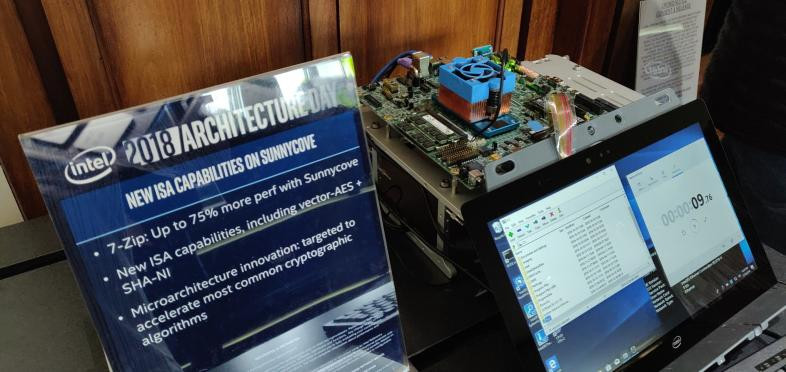- Joined
- Oct 9, 2007
- Messages
- 47,300 (7.53/day)
- Location
- Hyderabad, India
| System Name | RBMK-1000 |
|---|---|
| Processor | AMD Ryzen 7 5700G |
| Motherboard | ASUS ROG Strix B450-E Gaming |
| Cooling | DeepCool Gammax L240 V2 |
| Memory | 2x 8GB G.Skill Sniper X |
| Video Card(s) | Palit GeForce RTX 2080 SUPER GameRock |
| Storage | Western Digital Black NVMe 512GB |
| Display(s) | BenQ 1440p 60 Hz 27-inch |
| Case | Corsair Carbide 100R |
| Audio Device(s) | ASUS SupremeFX S1220A |
| Power Supply | Cooler Master MWE Gold 650W |
| Mouse | ASUS ROG Strix Impact |
| Keyboard | Gamdias Hermes E2 |
| Software | Windows 11 Pro |
Intel's semiconductor manufacturing business has had a terrible past 5 years as it struggled to execute its 10 nanometer roadmap forcing the company's processor designers to re-hash the "Skylake" microarchitecture for 5 generations of Core processors, including the upcoming "Comet Lake." Its truly next-generation microarchitecture, codenamed "Ice Lake," which features a new CPU core design called "Sunny Cove," comes out toward the end of 2019, with desktop rollouts expected 2020. It turns out that the 10 nm process it's designed for, will have a rather short reign at Intel's fabs. Speaking at an investor's summit on Wednesday, Intel put out its silicon fabrication roadmap that sees an accelerated roll-out of Intel's own 7 nm process.
When it goes live and fit for mass production some time in 2021, Intel's 7 nm process will be a staggering 3 years behind TSMC, which fired up its 7 nm node in 2018. AMD is already mass-producing CPUs and GPUs on this node. Unlike TSMC, Intel will implement EUV (extreme ultraviolet) lithography straightaway. TSMC began 7 nm with DUV (deep ultraviolet) in 2018, and its EUV node went live in March. Samsung's 7 nm EUV node went up last October. Intel's roadmap doesn't show a leap from its current 10 nm node to 7 nm EUV, though. Intel will refine the 10 nm node to squeeze out energy-efficiency, with a refreshed 10 nm+ node that goes live some time in 2020.




The transition from 10 nm+ to 7 nm EUV will significantly increase transistor-densities. Intel is also making the manufacturing process efficient, by reducing "design rules" by 4 times, giving chip-designers more flexibility and creative freedom in the way they design nanoscopic circuitry. The process will also be optimized for heterogeneous chip designs, Foveros packaging (a very advanced form of MCM), and EMIB (reduced footprint interposer).
The 7 nm EUV node will receive two major updates in quick succession. The 7 nm+ node is slated for 2022, and succeeding 7 nm++ node in 2023. Intel did not detail the two besides illustrating performance/Watt gains by almost as much as the transition from 10 nm+ to 7 nm. Elsewhere in the market, the early 2020s could see TSMC 6 nm EUV take center-stage, and Samsung implement its 5 nm EUV node.


Intel will build an Xe enterprise GPGPU based on 7 nm EUV for market release in 2021. The company was specific in mentioning that an "enterprise GP-GPU" will be built on it, and not its entire Xe lineup that includes client-segment, professional, and cloud GPUs. The Xe discrete GPU team, led by Raja Koduri, is probably making a ropewalk, by giving Intel "something" to build on its own fabs, while seeking out Samsung's cutting-edge 5 nm EUV node for the rest of its lineup. Intel confirmed that the its first 7 nm product will be a GPGPU, followed closely by a server CPU.
View at TechPowerUp Main Site
When it goes live and fit for mass production some time in 2021, Intel's 7 nm process will be a staggering 3 years behind TSMC, which fired up its 7 nm node in 2018. AMD is already mass-producing CPUs and GPUs on this node. Unlike TSMC, Intel will implement EUV (extreme ultraviolet) lithography straightaway. TSMC began 7 nm with DUV (deep ultraviolet) in 2018, and its EUV node went live in March. Samsung's 7 nm EUV node went up last October. Intel's roadmap doesn't show a leap from its current 10 nm node to 7 nm EUV, though. Intel will refine the 10 nm node to squeeze out energy-efficiency, with a refreshed 10 nm+ node that goes live some time in 2020.




The transition from 10 nm+ to 7 nm EUV will significantly increase transistor-densities. Intel is also making the manufacturing process efficient, by reducing "design rules" by 4 times, giving chip-designers more flexibility and creative freedom in the way they design nanoscopic circuitry. The process will also be optimized for heterogeneous chip designs, Foveros packaging (a very advanced form of MCM), and EMIB (reduced footprint interposer).
The 7 nm EUV node will receive two major updates in quick succession. The 7 nm+ node is slated for 2022, and succeeding 7 nm++ node in 2023. Intel did not detail the two besides illustrating performance/Watt gains by almost as much as the transition from 10 nm+ to 7 nm. Elsewhere in the market, the early 2020s could see TSMC 6 nm EUV take center-stage, and Samsung implement its 5 nm EUV node.


Intel will build an Xe enterprise GPGPU based on 7 nm EUV for market release in 2021. The company was specific in mentioning that an "enterprise GP-GPU" will be built on it, and not its entire Xe lineup that includes client-segment, professional, and cloud GPUs. The Xe discrete GPU team, led by Raja Koduri, is probably making a ropewalk, by giving Intel "something" to build on its own fabs, while seeking out Samsung's cutting-edge 5 nm EUV node for the rest of its lineup. Intel confirmed that the its first 7 nm product will be a GPGPU, followed closely by a server CPU.
View at TechPowerUp Main Site






 If anything, I'm a AMD fan myself, and I'd like to see AMD take some of the CPU market share, but this isn't a paper launch. You need model numbers, price, launch dates, performance tests and maybe even reviews for that.
If anything, I'm a AMD fan myself, and I'd like to see AMD take some of the CPU market share, but this isn't a paper launch. You need model numbers, price, launch dates, performance tests and maybe even reviews for that.



